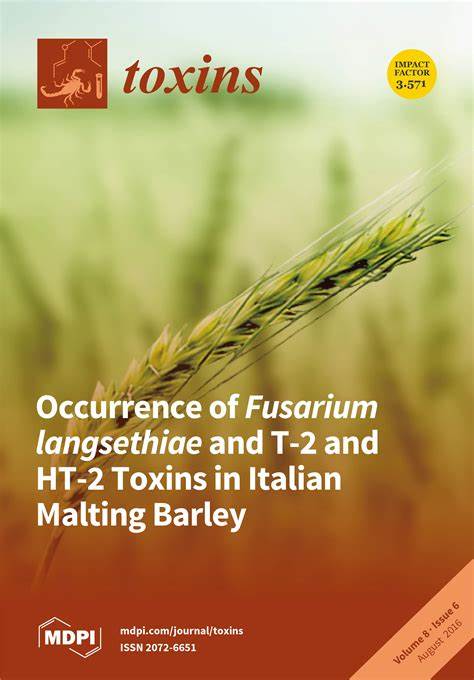蛋白质组和磷蛋白组分析揭示产气荚膜梭菌ε毒素在 MDCK 细胞中的毒性机制
IF 3.9
3区 医学
Q2 FOOD SCIENCE & TECHNOLOGY
引用次数: 0
摘要
伊普西隆毒素(ETX)是一种潜在的生物战和毒物战毒剂,会导致许多反刍动物死亡,并威胁人类健康。了解这种致死率高、传播速度快的毒素的毒性机制至关重要。本研究检测了 ETX 在 10 分钟和 30 分钟后对 MDCK 细胞蛋白质组和磷酸蛋白质组的影响。10 分钟组共筛选出 44 个差异表达蛋白(DEPs)和 588 个差异磷酸化蛋白(DPPs),30 分钟组共筛选出 73 个差异表达蛋白和 489 个差异磷酸化蛋白。ETX诱导的蛋白和磷酸化蛋白主要分布在细胞核、细胞质和线粒体中,其富集途径与转录和翻译、病毒感染和细胞间连接有关。同时,蛋白质-蛋白质相互作用网络筛选出了几个枢纽蛋白,包括SRSF1/2/6/7/11、SF3B1/2、NOP14/56、ANLN、GTPBP4、THOC2和RRP1B。几乎所有这些蛋白都存在于剪接体通路中,这表明剪接体通路参与了 ETX 诱导的细胞死亡。接下来,我们使用 RNAi 慢病毒和几个关键蛋白的抑制剂来验证这些蛋白是否发挥了关键作用。结果证实,SRSF1、SF3B2 和 THOC2 是参与 ETX 细胞毒性作用的关键蛋白。此外,我们还发现这些关键蛋白的共同上游激酶是 SRPK1,而降低 SRPK1 的水平也能减少 ETX 诱导的细胞死亡。这一结果与磷酸化蛋白质组学分析结果一致。总之,我们的研究表明,ETX 会诱导 SRSF1、SF3B2、THOC2 和 SRPK1 蛋白在剪接体通路上发生磷酸化,从而抑制 mRNA 的正常剪接并导致细胞死亡。本文章由计算机程序翻译,如有差异,请以英文原文为准。
Proteome and Phosphorproteome Profiling Reveal the Toxic Mechanism of Clostridium perfringens Epsilon Toxin in MDCK Cells
Epsilon toxin (ETX), a potential agent of biological and toxic warfare, causes the death of many ruminants and threatens human health. It is crucial to understand the toxic mechanism of such a highly lethal and rapid course toxin. In this study, we detected the effects of ETX on the proteome and phosphoproteome of MDCK cells after 10 min and 30 min. A total of 44 differentially expressed proteins (DEPs) and 588 differentially phosphorylated proteins (DPPs) were screened in the 10 min group, while 73 DEPs and 489 DPPs were screened in the 30 min group. ETX-induced proteins and phosphorylated proteins were mainly located in the nucleus, cytoplasm, and mitochondria, and their enrichment pathways were related to transcription and translation, virus infection, and intercellular junction. Meanwhile, the protein–protein interaction network screened out several hub proteins, including SRSF1/2/6/7/11, SF3B1/2, NOP14/56, ANLN, GTPBP4, THOC2, and RRP1B. Almost all of these proteins were present in the spliceosome pathway, indicating that the spliceosome pathway is involved in ETX-induced cell death. Next, we used RNAi lentiviruses and inhibitors of several key proteins to verify whether these proteins play a critical role. The results confirmed that SRSF1, SF3B2, and THOC2 were the key proteins involved in the cytotoxic effect of ETX. In addition, we found that the common upstream kinase of these key proteins was SRPK1, and a reduction in the level of SRPK1 could also reduce ETX-induced cell death. This result was consistent with the phosphorylated proteomics analysis. In summary, our study demonstrated that ETX induces phosphorylation of SRSF1, SF3B2, THOC2, and SRPK1 proteins on the spliceosome pathway, which inhibits normal splicing of mRNA and leads to cell death.
求助全文
通过发布文献求助,成功后即可免费获取论文全文。
去求助
来源期刊

Toxins
TOXICOLOGY-
CiteScore
7.50
自引率
16.70%
发文量
765
审稿时长
16.24 days
期刊介绍:
Toxins (ISSN 2072-6651) is an international, peer-reviewed open access journal which provides an advanced forum for studies related to toxins and toxinology. It publishes reviews, regular research papers and short communications. Our aim is to encourage scientists to publish their experimental and theoretical results in as much detail as possible. There is no restriction on the length of the papers. The full experimental details must be provided so that the results can be reproduced.
 求助内容:
求助内容: 应助结果提醒方式:
应助结果提醒方式:


